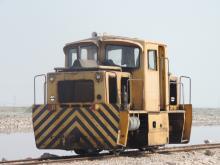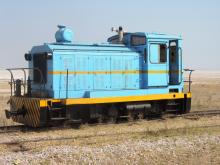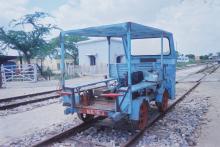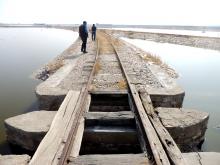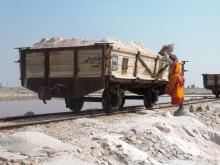The Indian epic Mahabharata mentions the Sambhar Lake as a part of the kingdom of the demon king Vrishparva, as the place where his priest Sukracharya lived, and as the place where the wedding between his daughter, Devayani, and King Yayati took place.[citation needed. A temple near the lake is dedicated to Devayani. The legend has it that Shakambhari Devi, the tutelary goddess of Chauhan Rajputs and the consort of Lord Shiva, converted a dense forest into a plain of silver as payment for some service. Subsequently, at the request of the inhabitants who dreaded the greed and strife that such a possession would beget, she transformed the silver plain into a lake. The name of the lake, Sambhar, stems from a variation Shakambhari, which happened around the sixth century. Another temple near the lake shore is dedicated to Shakambhari Devi.
Since the time of Mughals Sambhar Lake has been the site for salt production in India. It was leased by the British Government in 1869 for the production of salt by evaporation. The 'Northern India Salt Revenue Department' operated it with the first output being produced in 1870.
The Sambhar lake basin was divided by a 5.1 km long dam made of sand stone. After salt water reached a certain concentration, it was released from the west side to the eastern side by lifting dam gates. To the east of the dam were salt evaporation ponds where salt had been farmed for a thousand years. The eastern area comprised salt reservoirs, canals and salt pans separated by narrow dykes
In 1901 Sambhar salt works was incorporated. After independence Hindustan Salts Limited was incorporated on 12th of April 1958 as a Company fully owned by the Government of India to take over the salt sources at Sambhar, Didwana and Kharaghoda earlier managed by the Salt Department, Government of India. This is the only Central Government Public Sector undertaking engaged in the manufacture of salt. The Company started its business in January 1959.
Sambhar Salt Limited was incorporated on 30th of September 1964 as a subsidiary Company of Hindustan Salts Limited with 60% equity by the Government of India through Hindustan Salts Limited and 40% by Government of Rajasthan. Today it produces 196,000 tons of clean salt every year, which is 9% of India's total salt production
To the east of the dam is a railroad, built for transportation of salt. A meter gauge siding was constructed in 1875 by the Rajputana State Railway joining the 7.2km branch to the RSR mainline. The RSR in 1881-82 became the Rajputana-Malwa State Railway worked by the Bombay, Baroda and Central India Railway (BB&CIR), finally becoming the BB&CIR Sambhar Lake Salt Branch Line.
A John Fowler portable tramway was tried on an experimental basis on the salt pans but was unsuccessful and the equipment was sold in 1886-87. Between 1893 and 1896 the Salt Revenue Department hired locomotives and wagons from RMSR for the removal of salt from the salt pans to the depot. In 1915-16 a narrow gauge line was constructed at Nawa about 30 km from Sambhar on the north side of the lake and connected to Sambhar by the RMSR line.
At the time of independence 45 kms of MG and 25 Kms of NG was operational. The tracks run along the shores of the lake and branch out into an enormous network of MG and NG lines. At various points, the lines branch inward toward the salt pans where the raw salt is collected through evaporation of saline water. Temporary branches are laid from these lines running in to the pans which are currently in use. The Sambhar Salts rail system looks like a capital "E" on its side, with the lower line (running along the southern edge of the lake) and the two outer uprights meter gauge, while the center upright is narrow gauge. The wagons are built on a metal chassis, but have a wooden body to reduce corrosion.
Today the track condition is very poor, with many rotten timber sleepers and missing dog spikes. There were once two narrow gauge locomotives- A 125 horsepower VENTRA (Venkateswara Transmissions & Locomotives Limited, Hyderabad, 1985 built) locomotive and a 200 horsepower OEPL (Ovis Equipment Private Limited, Hyderabad, 2004 built) locomotive. Today only the light blue OEPL locomotive is in operation, hauling the small four-wheel wagons with steel frames and timber bodywork. The other locomotive is in bad rusted condition.
There are two meter gauge locomotives- A 335 horsepower SAN (Suri and Nayar Engineering & Locomotive Company Limited, Bangalore, 1981 built) locomotive and a 150 horsepower TELCO (Tata Engineering & Locomotive Company, Jamshedpur, 1968 built) locomotive. Both of them is in operation. The large blue SAN locomotive is too heavy to be used on the poor track out on the lake, and is therefore confined to operation on just over two kilometers of track between the salt works and the point where the line drops down onto the lake surface. It brings empty wagons out and then waits for the TELCO locomotive to bring loaded wagons back to the handover point.
There are four wheel inspection trollies powered by a petrol engine. At the peak of railway operations there were five inspection cars. All of these could be reversed using a jack.
The Salt works celebrated its centenary in 2001 when several new wagons were added to the rolling stock. The inspection car No-5 was added to the fleet. However over time lack of funds has ensured that track maintenance is low and on any given day only two locomotives are in operation.
The government has recently unveiled ambitious plan to develop the lake as a major tourist destination.

